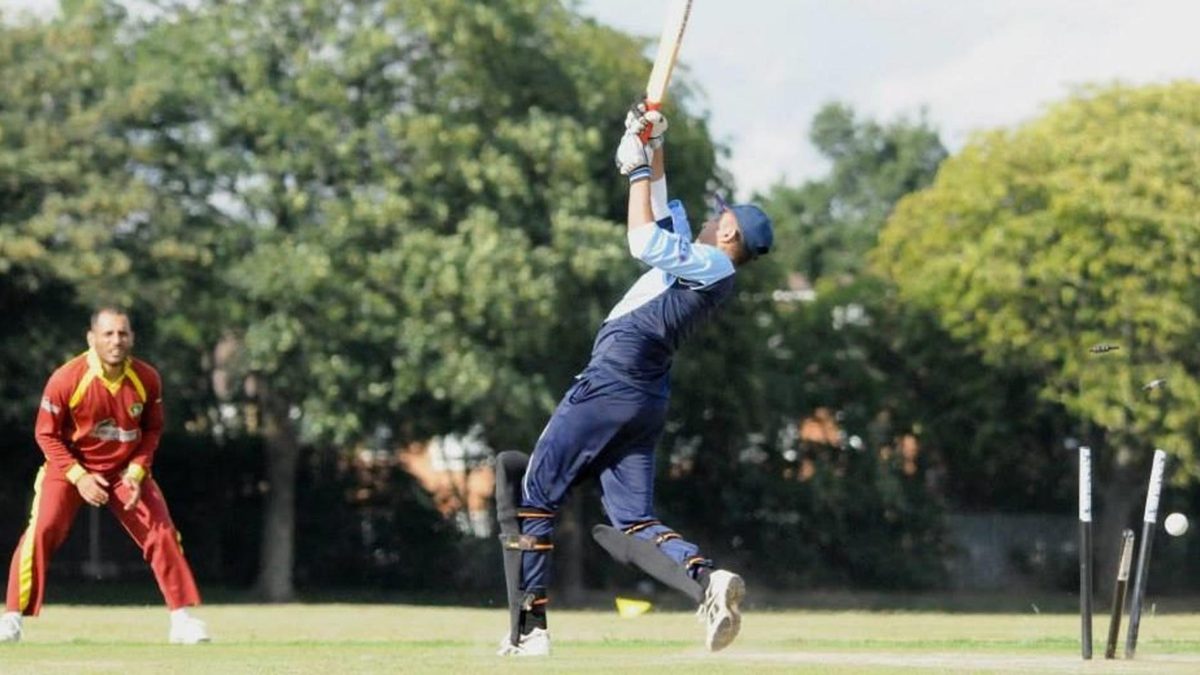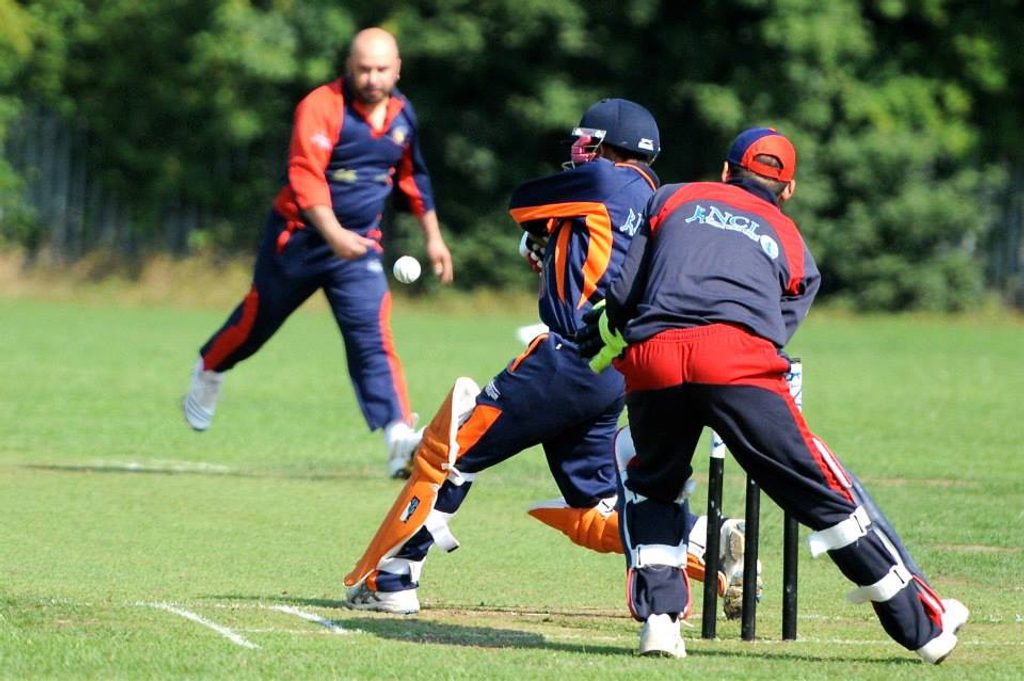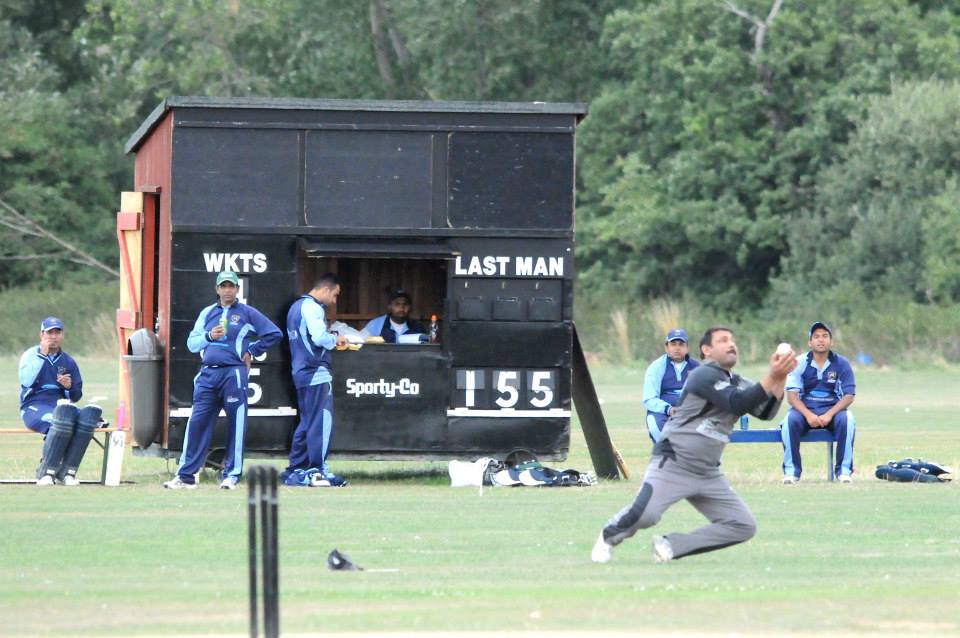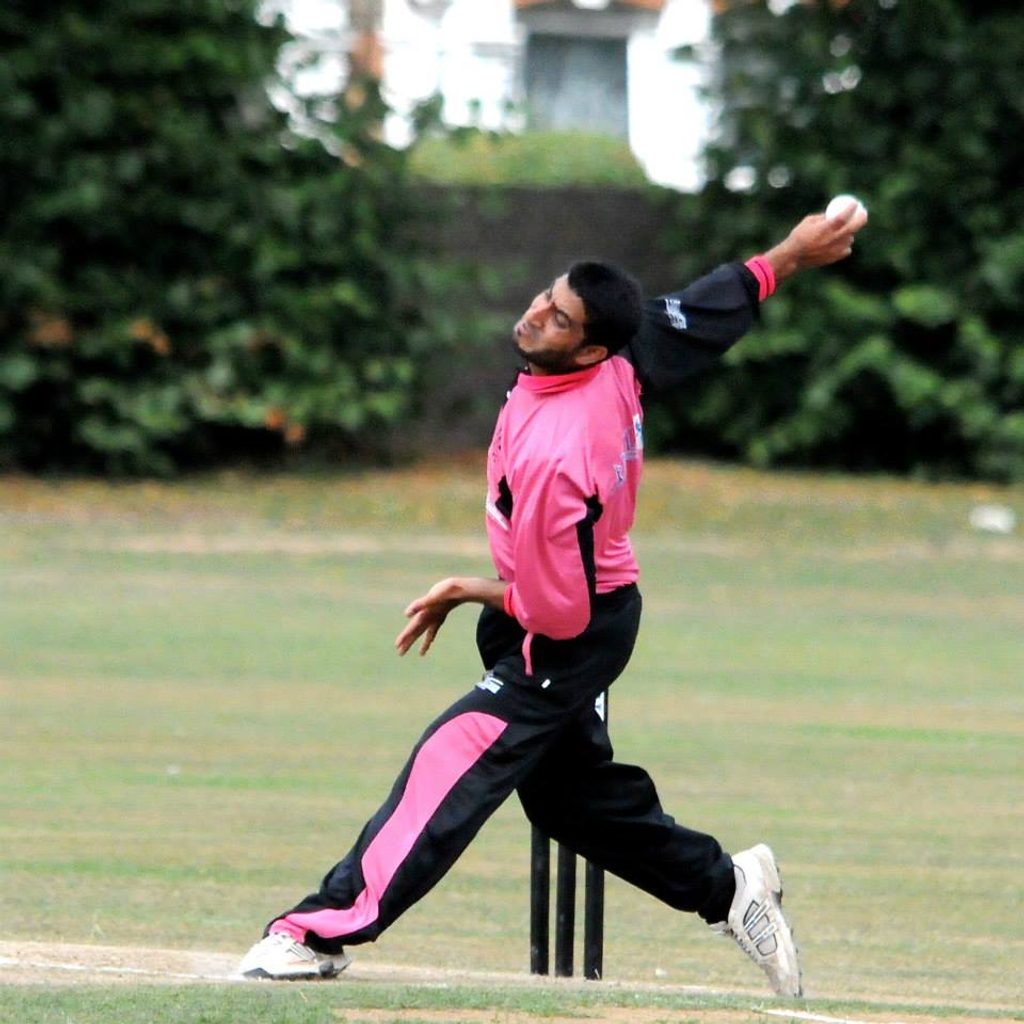
British Asians in mainstream clubs, the recognised parks leagues and unseen streets hold the future of cricket as a popular national sport in their hands, says Sahil Dutta.
This is an adapted extract from The Show Must Go On: a century of club cricket in the south of England, published in 2015
Originally published in 2015
It felt like the first day of every English cricket season, cold. Gun-metal grey, gusting winds and under their coloured cricket jerseys, players wore two, sometimes three layers. Also, it was clearly still football season, in a football country.
The Ford Social and Sports Club in Ilford, Essex, was established in the 1950s when Ford’s Dagenham factory fed the area’s economy. It was now drab, transfixed in a style from a generation past. On a mid-April Sunday morning it played host to an endless expanse of football matches. It was also supposed to host the National Cricket League’s season opener: a charity T10 tournament.
Eight teams had arrived for the big day, and eight more were already in action at the Walker Ground in Southgate. At Ilford many of the cricketers milled about on the outfield, rubbing hands together, wincing at catches, and ‘warming up’ with stiff-looking bowling actions. Others, like much of the ‘Oceans XI’ team, thawed out at the bar. Just tea and cola, of course, since many of Ocean XI’s players didn’t drink alcohol.
[caption id=”attachment_70787″ align=”alignnone” width=”960″] The National Cricket League in action[/caption]
The National Cricket League in action[/caption]
Their cricket outfits were bright green (all the teams were in technicolour) and had nicknames emblazoned on the back: ‘Mr Khan’; ‘RAZZY D’. The fronts and arms were plastered with sponsors’ labels, a local fried chicken and pizza shop.
Around the ground some young men had spiked, dyed hair, others reversed baseball caps, and others still the traditional Muslim taqiyah. Almost everyone who could wore some kind of beard. It was a sweep of Greater London’s south Asian community. Dads and uncles with their boys; wives, mothers, daughters and aunties elsewhere, apparently. It was already past 11am, the tournament was supposed to have started more than an hour ago. But still everyone waited.
“There’s been a bit of a problem,” Sajid Patel, secretary of the NCL who was organising the day, told me. “The groundskeeper has said we can’t play here today. It’s a real shame, all the guys were so excited for it. I’m trying to make some calls to see what we can do.”
[breakout]When so many British Asians play for fun and so few (about six per cent) professionally, something is awry[/breakout]
Sajid is a huge guy, six-foot-five he says. His downward-sloping eyebrows and toothy smile give him a gentle manner, but he was clearly annoyed. Whether a misunderstanding or something more pointed, the ground’s facilities manager had decreed “round robin” events prohibited. It felt arbitrary. The ground had been hired for the day, the teams had arrived and “round robin” or not, there would only ever be one match happening at a time.
Despite Sajid’s protestations it wasn’t to be. The tournament was postponed and almost 90 players drifted back to their normal Sunday lives. The Ford ground remained football only for another week, and cricket took another, quiet blow. As I was leaving Sajid smiled and explained: “We’re used to these kinds of challenges.”
***
The 2015 edition of the Wisden Almanack warned that English cricket was becoming distant from the British population. The ECB’s own figures, though hardly scientific, showed participation flagging and spoke of a sport struggling for popular relevance. Over the course of a year the equivalent of 5,818 playing XIs had been lost, and of the thousands of people that were still playing cricket, many did not do so regularly.
All of which makes British Asian cricket something to celebrate, because the south Asian game is thriving in England. Officially, they play over a third of all recreational cricket, but that ignores the fevered matches that take place in carparks, street corners and council-owned pitches around the country. This off-grid cricket lies outside ECB oversight and is unregulated and impossible to catalogue. Between them, British Asians in mainstream clubs, the recognised parks leagues and unseen streets hold the future of cricket as a popular national sport in their hands.
Yet when so many British Asians play for fun and so few (about six per cent) professionally, something is awry. For the last two generations the mainstream English game and the British Asian game have stood apart, though things may finally be changing. The ECB has recently attempted to bridge the gap and in 2014 announced a ‘national south Asian engagement programme’ to try and ‘connect’ with 10,000 south Asians. Counties received funding for diversity training, the ECB brought England players to community cricket festivals, and goodwill was extended all round. No panacea, but after decades of mutual neglect, an important step.

Changing attitude though, does nothing to shift deeper infrastructural problems. Simply, there aren’t enough cricket grounds left in urban Britain. Twenty thousand playing fields have been lost since 1990 and in London, where luxury housing developments are more lucrative to cash-strapped councils than cricket grounds, there has been a 40 per cent fall in the number of pitches over the last 20 years. The ECB is experimenting with new forms of the game, adapted for tightly enclosed urban settings and in years from now this might prove fruitful, but they are no replacement for what has been lost.
It is why places like Victoria Park in east London are so sacred. Among the fashionistas revelling there in summer you also find an authentically retro scene: inner-city cricket. Teams play cup games on weekday evenings and all day on weekends as part of the Victoria Park Community League. The league was founded in the early 1990s and at the time was almost the only organised cricket in Tower Hamlets and Newham, two of London’s most-populated and ethnically diverse boroughs. The community league is successful and recruits players that well represent the multicultural population, but the cricket is gentle. More akin to the village game than anything more flinty. Instead, it’s a couple of miles up the road from Victoria Park – at the Leyton County Ground – where south Asian cricket really gets serious.
***
It is in Leyton where you’ll often find Sajid Patel and the best matches from the NCL. Like so many, Sajid owed his love of the game to his family. His dad, Dilwar, had come to England in 1968 from the Bharuch district in Gujarat, north India. Dilwar was a keen cricketer and he and fellow migrants from the same community immediately came together to play cricket. They founded the Leytonstone Cricket Club two years later which played park games mainly, but also entered an XI in the Middlesex League and the Colour Assembly League in Essex in the 1970s. Of course, they didn’t have a ground, and were sub-letters to the mainstream English clubs, playing their ‘home’ games at Leyton, Hackney Marshes and Lea Valley Park.
Seventies London was not always accommodating to these still fairly recent migrants. Many of Dilwar’s friends and relatives preferred to play among themselves than deal with the hostile attitude of other teams. With his family steeped in the game Sajid was always going to play cricket, and he wanted to play it properly. For a while he was at Wanstead CC but couldn’t get a fair outing. Eventually his dad’s frustration turned to innovation as Dilwar helped found the Gujarati Metropolitan Cricket League in 1993. The league still runs today with two divisions and a cup tournament and, affiliated to the Essex county, is “open to anyone”. When it started, though, it was a haven for London’s Gujarati Muslim community. “It was a similar concept to the IPL in a way,” explained Sajid. “Seven players from each team had to be Gujarati Muslim and four players could be from any background.” Though Sunday cricket, the GMCL was a high standard.
[breakout]“We’re trying to get away from the parks cricket label and see ourselves as potentially mainstream cricketers”[/breakout]
What Dilwar couldn’t have known when he helped start Leytonstone CC in 1970 is the legacy the venture would have. The GMCL continues today and its spin-off, the NCL, is now a behemoth of south Asian cricket in London and Essex. On first sighting ‘National Cricket League’ is a misleading name. The league comprises 39 clubs, none of which hail many miles out from Leyton. But with players from Britain’s Bengali, Pakistani, Sri Lankan and Indian communities, it is more representative of ‘the nation’ than much of the English game. They play across four divisions, with a T20 tournament, Pro40 cup, and a four-stump 10-over knockout event for charity. A lot of cricket. The club names give an insight to their role models: Leytonstone Cricket Club are now called the Leytonstone Lions, and their opponents include the Cornered Tigers CC, Smashers CC and the Mumbai Indians.
The league entered its fifth season in 2015. Each year it has expanded: more clubs, more teams, more people playing the game that is supposed to be on the wane. Playing stocks are never a worry, the only real limit on growth is the lack of facilities. Leytonstone Lions still have no permanent home, and neither do most of the teams in the league. It is only a recent partnership with Essex to use the Leyton County Ground that has allowed the league to grow.
“We’re trying to get away from the parks cricket label and see ourselves as potentially mainstream cricketers,” said Sajid. “Essex have managed to help us get meetings with different groundsmen and Leyton County Ground is our hub. We got that two years ago and it’s crucial.”

Unlike the GMCL, which mostly plays traditional-style games, the NCL concentrates on short-form cricket. “A lot of people are actually coming over from Saturday league cricket to come and play Twenty20 with us. With work or family commitments people have moved away from the traditional English-style clubs to play three hours of cricket instead.”
There might be a lesson here. With world cricket’s professional game skewed ever further towards the shortest form, is traditional club cricket not out of step with its half-speed, all-day format?
***
Look widely enough and you’ll find British Asian cricket played all over England. So why something so everyday feels so marginal is the riddle waiting to be solved. One issue is that because there are no few home grounds or colts system, parks cricket is still played independently, or within specific diasporas. Rarely are these disparate pieces knitted together. Unlike the traditional club scene, there are few development pathways or umbrella organisations under which the many players, teams, clubs and leagues can belong. The ECB hopes to fix this by increasing the board’s own ‘visibility’ in these areas, but the British Asian community itself is trying to find a collective voice.
Gulfraz Riaz, development officer at the Club Cricket Conference, has spent the past few years pushing for greater recognition for south Asian cricketers in England. Starting in London and the sout-east, Gulfraz took to his car to personally seek out and speak to teams and league secretaries that were previously unseen by the English game.
[breakout]A flood of cricketing love and talent is poised to burst through, but the question is whether resources can be unlocked and shared in the other direction too[/breakout]
His aim was expanding the network of teams affiliated to the Club Cricket Conference, but the more he visited the more he felt they needed fuller representation. “It wasn’t a case of picking up the phone and telling them they now belong to us,” he said last year. “It was a case of going there, talking to them, and understanding their achievements and needs.” There are now 13 leagues affiliated to the CCC, totalling over 300 teams and 5,000 players and plans are in place to establish an organisation dedicated to representing British Asian cricket. “For the first time [these clubs] have a chance to share ideas and concerns with each other,” he told me. “It’s given them a voice.”
The links forged have given British Asian cricket a toe-hold on the professional game for the first time. In May 2014 a select south Asian Cricket Leagues XI, featuring the best players from the various parks leagues, played Essex Second XI in a bank holiday Twenty20 game. Though a festival match for the county and good all-round fun, it is spoken of very seriously by those involved in south Asian cricket in Essex. It catapulted Pakistani-born Tanvir Sikander into the Essex County Championship team in 2014 and many of the British Asian players I spoke to now feel they too have chance, however slight.
[breakout type=”related-story” offset=”0″][/breakout]
That is a huge change. It has been almost 50 years since people like Dilwar Patel, Salim Yasin and Gulfraz Riaz came to Britain and established a cricket welcome to migrant players. After decades of mutual suspicion with the mainstream English game, it is proof of how attitudes are beginning to thaw. A flood of cricketing love and talent is poised to burst through, but the question is whether resources can be unlocked and shared in the other direction too.
Whatever happens at the elite level, though, it is worth celebrating the weekend heroes, who in the scrappy parks and built-up cities around England, have helped keep cricket thriving.
SUGGESTED READ:
https://www.wisden.com/stories/news-stories/ecb-reveals-plan-to-better-engage-with-south-asian-communities








